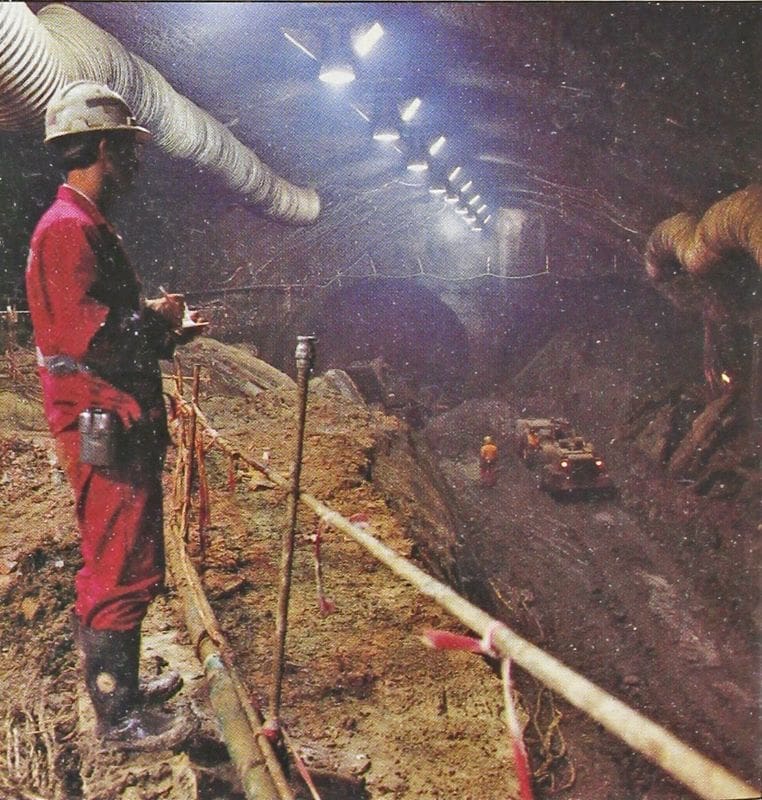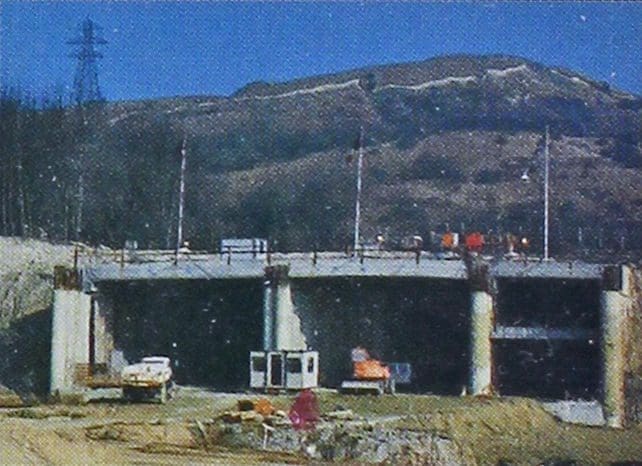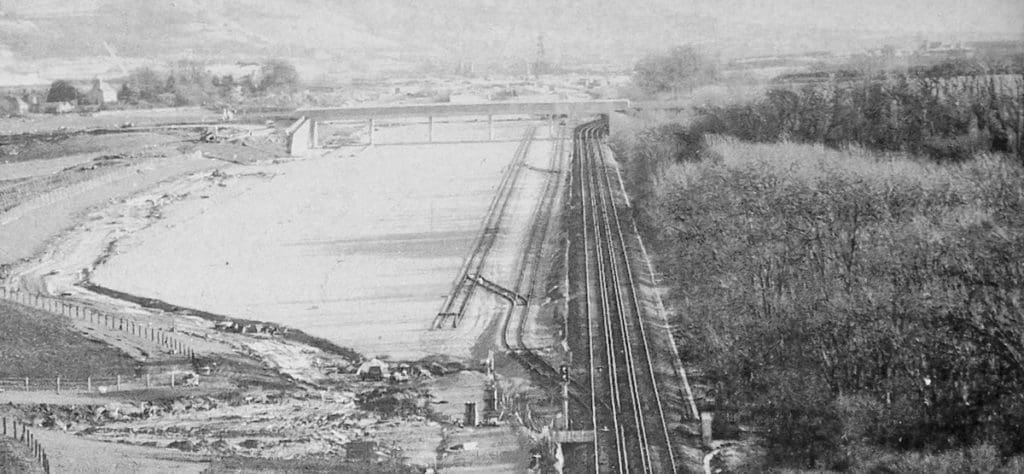From the archive: The pace quickens
An update on the progress of the Channel Tunnel by P. W. B. Semmens MA, C.Chem, FRSC, MBCS, MCIT from November 1990
 The BR consultation drawing of the proposed high-speed rail link across Kent, currently being discussed. The 450-metre tunnel at Warren Wood is too short to be shown in the diagram.
The BR consultation drawing of the proposed high-speed rail link across Kent, currently being discussed. The 450-metre tunnel at Warren Wood is too short to be shown in the diagram.
THERE were several important developments with the Channel Tunnel and its related Rail Link during the second week in September. Not only did the boring machine in the North Running Tunnel break through into Holywell Coombe, but formal planning protection was given by the government to the route of the high-speed rail link across eastern Kent. As a result, detailed environmental consultations were re-started by British Rail with all concerned. In addition to this, the British North Running Tunnel TBM had broken through into the Cross-Over Cavern at the end of August, while less than two miles separated the two ends of the Service Tunnels underneath the Channel. By the time this appears in print, there will be only days to go before the two boring machines are in contact, ready to meeting November, although the formal ceremony to mark the completion of Britain’s first fixed link with the Continent is not scheduled to take place until the New Year.
 The sheer size of the Cross-Over Cavern is apparent from this picture, taken in the summer, looking westwards towards England. The North Running Tunnel TBM broke through into this on 27 August, and has since traversed the cavern to continue eastwards to meet the French TBM in less than a year’s time. Now that the cavern is connected to one of the running tunnels, management of the construction trains will be greatly eased, as all spoil removed from the cavern, as well as lining materials, could only travel previously through the Service Tunnel
The sheer size of the Cross-Over Cavern is apparent from this picture, taken in the summer, looking westwards towards England. The North Running Tunnel TBM broke through into this on 27 August, and has since traversed the cavern to continue eastwards to meet the French TBM in less than a year’s time. Now that the cavern is connected to one of the running tunnels, management of the construction trains will be greatly eased, as all spoil removed from the cavern, as well as lining materials, could only travel previously through the Service Tunnel
A walk through the Tunnel
Article continues below…Advert[1]In mid-August, just over a year since I had last toured the area, I paid another visit to the Eurotunnel terminal site at Folkestone. Not only were there many changes to be seen on the surface, but I was able to walk through part of the tunnel and note the different types of construction used in the first section which will be traversed by passengers leaving Britain.
Our press party was taken by minibus to Holywell Coombe, where we descended a temporary stairway into one of the TBM dismantling chambers at the west side of Sugar Loaf Hill. These have been constructed where the bored tunnels will finish and give way to the box-section ones, built in the open, which connect with those through Castle Hill. At the time of the break-through of the Service Tunnel in November last year, the box-section construction extended only part way across the coombe, and guests at that ceremony climbed steps into the open ends to walk towards the point where the TBM would appear. Since then, not only have the concrete boxes been linked up at both ends, but they have been completely covered with spoil, which is now being landscaped to blend in with the remainder of the coombe.
Where the three tunnels emerge from the hillside they are in the normal position. with the Service Tunnel between the two running ones, but, as they cross the coombe, the service one dives under the South Running Tunnel to come up on its outside. This enables all three to emerge side-by-side from the Western Portal, without access to the Service Tunnel being hindered by any intervening rail tracks. Walking up the l in l00 gradient from the point where the TBM was to emerge less than a month later, it was possible to see the three different types of tunnel, produced by boring machine. box construction, and the New Austrian Tunnelling Method (NATM). The last in method had been used through the unstable ground of Castle Hill, and the initial skin of sprayed concrete had already been covered with the main lining, which was cast in situ. It had a roughly circular cross section, like the bored tunnels, in marked contrast to the rectangular box of the stretch originally built in the open.
Article continues below…Advert[2] A view through the Castle Hill section of the South Running Tunnel. The reinforcing rods for the final in situ concrete lining are being fixed inside the yellow plastic waterproofing membrane
A view through the Castle Hill section of the South Running Tunnel. The reinforcing rods for the final in situ concrete lining are being fixed inside the yellow plastic waterproofing membrane
Even within such a short distance of the portal, cross-passages between the running and service tunnels have still to be provided every 375 metres. and the standard design cannot be used in this stretch because of the different layout of the three bores. The cross-passage directly links the two running tunnels, and there is a connection down some stairs to the Service Tunnel. As our party crossed over from the North to the South Running Tunnel by this means, I was immediately struck by the difference in appearance. Instead of the bare concrete walls in the former, the southern one had a lovely yellow quilted lining. However, this was not part of the interior designersë art, but was the plastics sheeting forming the waterproof membrane between the initial and final linings. This is shown in one of the illustrations, but that was taken after the reinforcing rods had been put in position, obscuring some of the sheeting. The effectiveness of the NATM was demonstrated by the fact that, although the tunnelling through Castle Hill was completed in 1989, it was not necessary to insert the massive final lining immediately, the sprayed-on material giving quite sufficient stability for many months.
Later during the tour we drove into the reversing loop for the shuttle trains at the western end of the site, the concrete box for which had also been landscaped with spoil, while beyond it trees were growing on the noise bund protecting the villages of Newington and Peene. Although this tunnel is only about half a mile long, the safety specification still calls for continuous walkways alongside each of the three tracks for evacuation purposes, and there are smoke vents at the quarter, half and three-quarter points. With safety standards of this sort being adopted for this project and other similar ones elsewhere in Europe, it is not surprising that an independent assessment of the risks in the tunnel under the Great Belt in Denmark has shown that they are less than those of an ordinary twin-track railway, let alone a road.
High-Speed Rail Link
Article continues below…Advert[3]ON 13 September the Department of Transport issued its promised directive to protect the corridor earmarked for the BR rail link between Swanley and Dollands Moor. Any local authority now has to refer to BR any planning applications affecting the latterís zone of interest, which roughly coincides with the existing area where its voluntary purchase scheme operates. BR can then object if the proposed development would interfere with its plans, but the normal appeal procedure continues to operate.
At the same time, BR released its new plans for the alignment of the 140mph link, thus starting the detailed consultation procedure with all interested parties. Some changes have been made to the 1989 plans, and these should considerably benefit all parties directly involved, as well as the rest of the country, who see how much our future national prosperity depends on a fast link with the continent. Horizontally the maximum change in the alignment is no more than 300 metres, and in the vertical plane it is even less, but the effects of the latter are significant.
First of all, the area of land that has to be acquired is considerably reduced, which is an important consideration at a time when many people are concerned at the loss of our rural acres. Much less spoil will also have to be removed from the area. The 1989 plans would have involved removing 3m cubic metres of material, which corresponds to some 200,000 lorry movements.
Article continues below…Advert[4] Four tracks will emerge from the portal of the reversing loop in the middle-distance, fanning out to enter eight loading and unloading platforms. In the centre, work progresses on Overbridge No. 1
Four tracks will emerge from the portal of the reversing loop in the middle-distance, fanning out to enter eight loading and unloading platforms. In the centre, work progresses on Overbridge No. 1
The new plans should reduce the volume to 100,000 cubic metres, and some of this might even be absorbed in the construction of noise bunds alongside the line. In the course of the last year a noise prediction model was being prepared, and this has now been validated by measurements made alongside the TGV-A line in France. Work has also shown that simple noise fences or bunds will reduce the emissions by up to 10dB(A), thus halving the perceived noise levels. The noise from the link will thus be less than that from existing railways in Kent, supporting the many comments I have made on this subject.
The 1990 plan will also benefit those who will use the line, primarily by eliminating several small tunnels, the pressure pulses from which will inevitably be felt inside the trains. In addition to the tunnel under Ashford, and the long one beginning at Swanley, a 450ómetre one at Warren Wood remains, between Hollingbourne and Harrietsham. The biggest visual change is that the embankment taking the line across the Boxley Valley in the 1989 plans has been replaced with a viaduct, 750 metres long with a maximum height of 19 metres (62ft) above the ground. The Royal Fine Arts Commission will be asked to advice on its detailed design.
 Out benath the Channel workers prepare to move the North Running Tunnel TBM through the British Cross-Over Cavern, so it can continue towards France
Out benath the Channel workers prepare to move the North Running Tunnel TBM through the British Cross-Over Cavern, so it can continue towards France
Initially there appeared to be some adverse reaction locally to this idea of a viaduct, but, as Gil Howarth, the BR Project Director, pointed out. many others throughout the country have long since been ëlistedí, including the one built by “Concrete Bob” McAlpine at Glenfinnan. That at Boxley will be a relatively low one, but some of the really high ones on the German Neubaustrecke are magnificent additions to the landscape, with massive arches breaking up the succession of vertical piers. Overall, the new proposals in this area will reduce the cost of this part of the Rail Link by 10-20 per cent, but specific figures are not available.
West of Swanley, the alignment of the Rail Link is still not fixed, and BR will be reporting its preferred option to the government in the spring of I991. This is after discussions have been completed with the syndicates advocating routes via the north bank of the Thames. These are well under way, and involve, among other things, re-costing the proposed Stratford terminus as a through station, as it has been accepted that the second terminal has to be at Kings Cross to give the necessary interchanges for the rest of the country. For that reason too, the existing voluntary purchase scheme still applies to the Warwick Garden area in South London, which could be the junction point for a connection to Kings Cross from the existing boat-train routes. The implications of the high-speed line for commuter and leisure travel in London were also mentioned, and BR considered that, in addition to being the countryís international rail link, it equally formed ìa new line for the people of Kentî.
Some excellent information material about the plans and implications is now available, and copies were sent to all households concerned on 13 September. In addition, a mobile information office was to go on a four-week tour of the villages along the line, and parallel consultations were taking place with MP5, the Kent County Council and the district councils, and local pressure groups.
 The western end of the Channel Tunnel earlier in the year. The North Running Tunnel is on the left, the South one in the centre
The western end of the Channel Tunnel earlier in the year. The North Running Tunnel is on the left, the South one in the centre
Tunnel breakthrough
AT 11.40 on 19 September, the second of the British running tunnel TBMs broke through into the crossover cavern, having covered the 7.8km from Shakespeare Cliff in just I5 months. In addition to the completion of this section of the operating tunnel, the logistics management of the construction transport system will be further improved now the two sets of narrow-gauge tracks have made physical contact in the cavern.
On the same date, the North Running Tunnel TBM was already 150 metres beyond the cavern, heading for the meeting-point in mid-Channel.
 Dollands Moor Channel Tunnel Freight Sidings under construction, showing two temporary access sidings in place for the unloading of material for the Cheriton Passenger Terminal
Dollands Moor Channel Tunnel Freight Sidings under construction, showing two temporary access sidings in place for the unloading of material for the Cheriton Passenger Terminal
Explore The Railway Magazine archive for more articles like this one.[5]
Advert[6]Railway Reads
From the history of steam through to 21st century rail transport news, we have titles that cater for all rail enthusiasts. Covering diesels, modelling, steam and modern railways, check out our range of magazines and fantastic subscription offers.[7]Get The Railway Hub Weekly Round-up
Enter your e-mail address below and you will receive weekly rail news straight into your inbox… You can unsubscribe at any time.References
- ^ Advert (www.therailwayhub.co.uk)
- ^ Advert (www.therailwayhub.co.uk)
- ^ Advert (www.therailwayhub.co.uk)
- ^ Advert (www.therailwayhub.co.uk)
- ^ Explore The Railway Magazine archive for more articles like this one. (www.railwaymagazine.co.uk)
- ^ Advert (www.therailwayhub.co.uk)
- ^ subscription offers. (www.classicmagazines.co.uk)